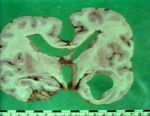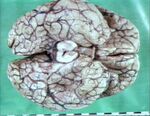Difference between revisions of "CNS Congenital Abnormalities - Pathology"
Jump to navigation
Jump to search
(Redirected page to Category:Central Nervous System - Congenital Abnormalities) |
|||
| (3 intermediate revisions by the same user not shown) | |||
| Line 1: | Line 1: | ||
| − | + | {{review}} | |
| + | |||
| + | {{toplink | ||
| + | |backcolour = E0EEEE | ||
| + | |linkpage = Nervous System - Pathology | ||
| + | |linktext =Nervous System | ||
| + | |maplink = Nervous System (Content Map) - Pathology | ||
| + | |pagetype =Pathology | ||
| + | }} | ||
| + | <br> | ||
| + | ==Introduction== | ||
| + | |||
| + | * Congenital malformations may involve the spinal cord, brain, meninges, calvaria or vertebral column. | ||
| + | * Abnormalities typically result from defects in neural tube development. | ||
| + | * Congenital malformations are present at or before birth, and manifest as either: | ||
| + | ** Morphological problems | ||
| + | ** Functional problems | ||
| + | *** Tend to arise as biochemical abnormalities, such as the lysosomal diseases or leukodystrophies. | ||
| + | * Causes of congenital abnormalities include: | ||
| + | ** Environmental causes | ||
| + | *** For example, these may be toxic, infectious, nutritional, or physical (e.g. radiation) | ||
| + | *** This is by far the most common cause. | ||
| + | ** Inherited traits. | ||
| + | |||
| + | ==Meningoencephalocoele== | ||
| + | |||
| + | * A defect in the cranium allows protrustion of the brain and meninges. | ||
| + | ** There is always crania bifida (a split skull). | ||
| + | * Meningoencephalocoele may be inherited in pigs and cats. | ||
| + | |||
| + | ==Hydrocephalus== | ||
| + | [[Image:hydrocephalus.jpg|thumb|right|150px|Hydrocephalus in situ]] [[Image:hydrocephalussection.jpg|thumb|right|150px|Hydrocephalus. Image courtesy of BioMed Archive.]] [[Image:aqueductstenosis.jpg|thumb|right|150px|Aqueduct stenosis. Image courtesy of BioMed Archive.]] | ||
| + | * Hydrocephalus is an increased accumulation of fluid in the cranial cavity. | ||
| + | * There are several different types of hydrocephalus relating to where the fluid is located within the cavity. | ||
| + | ** '''Internal''' hydrocephalus - fluid is within the <u>ventricles</u> | ||
| + | *** The most common type. | ||
| + | *** There is unilateral or bilateral dilation of the ventricles. | ||
| + | ** '''External''' hydrocephalus - fluid is within the <u>arachnoid space</u> | ||
| + | ** '''Communicating''' hydrocephalus - fluid is within the <u>ventricles and arachnoid space</u> | ||
| + | ** '''Hydrocephalus ex vacuo''' - the <u>ventricle is dilated secondary to loss of cerebral tissue</U> | ||
| + | *** Also known as compensatory hydrocephalus. | ||
| + | |||
| + | [http://w3.vet.cornell.edu/nst/nst.asp?Fun=F_KSsrch&kw=HYDROCEPHALUS View images courtesy of Cornell Veterinary Medicine] | ||
| + | |||
| + | ===Causes=== | ||
| + | |||
| + | * Hydrocephalus may be '''congenital'''. | ||
| + | ** Congenital hydrocephalus is common in brachycephalic and small breed dogs. | ||
| + | *** It occurs sporadically in cattle. | ||
| + | ** Obstructive lesions are often not found. | ||
| + | ** Amalformed mesencephalic aqueduct may be involved. | ||
| + | ** The cranium may be abnormal, for example, doming. | ||
| + | * '''Acquired''' hydrocephalus is the result of obstruction, usually due to inflammation or compression. | ||
| + | ** Space-occupying lesions include : | ||
| + | *** Neoplasms | ||
| + | *** Abscesses | ||
| + | *** Cholesteatomas | ||
| + | ** Inflammation of meninges and/or ependymal cells can lead to hydrocephalus. | ||
| + | *** For example, FIP causes ependymitis which can obstruct flow if it affects the mesencephalic aqueduct. | ||
| + | * Hydrocephalus may also arise with: | ||
| + | ** Increased ventricle size due to loss of brain parenchyma. | ||
| + | ** Overproduction of CSF | ||
| + | *** Rare | ||
| + | *** Associated with choroid plexus tumours. | ||
| + | |||
| + | ===Breed predisposition=== | ||
| + | |||
| + | * Some breeds are predisposed to hydrocephalus. | ||
| + | ** Chihuahua, pomeranian, yorkshire terrier, english bulldog, lhasa apso, toy poodle, cairn terrier, boston terrier, pug, pekingese, maltese terrier. | ||
| + | ** Hydrocephalus has also been described in | ||
| + | *** Bullmastiffs, in association with cerebellar ataxia. | ||
| + | *** Siamese cats, as an autosomal recessive trait. | ||
| + | |||
| + | ===Clinical Signs=== | ||
| + | |||
| + | * Clinical signs are the result of: | ||
| + | ** Loss of neurons or neuronal function | ||
| + | ** Alterations in intercranial pressure | ||
| + | ** Pathophysiological effects of intracranial disease | ||
| + | * Signs reflect the anatomical level of disease involvement. | ||
| + | ** Rostrotentorial, vestibular and cerebellar signs are most common. | ||
| + | * Signs are not related to the degree of ventricular dilation. They are more associated with other damage caused by the disease proces: | ||
| + | ** Intracranial pressure changes | ||
| + | ** Intraventricular haemorrhage | ||
| + | ** Speed of ventricular obstruction | ||
| + | * Hydrocephalus may contribute to abnormalities of skull development, where it is a congenital disease. | ||
| + | ** Thinning of the bone structure | ||
| + | ** Dome-shape head | ||
| + | ** Persistent fontanelles | ||
| + | * Ventral or lateral strabismus may occur, although the reason for this is unknown. | ||
| + | ** May be related to distortion of the orbits, due to skill deformity. | ||
| + | ** May be realted with pressue on the mesencephalic tegementum. | ||
| + | |||
| + | ===Diagnosis=== | ||
| + | |||
| + | * Diagnosis is by a variety of imaging and electrophysiologic methods. | ||
| + | ** MRI allows examination of the ventricular system, and give better resolution of the brain parenchyma than CT. | ||
| + | |||
| + | ===Treatment=== | ||
| + | |||
| + | * Prognosis is generally poor. | ||
| + | * Medical treatment: | ||
| + | ** General supportive care | ||
| + | ** Medications to limit CSF production and reduce intracranial pressure. | ||
| + | * Surgical treatment: | ||
| + | ** Aims to allow drainage of CSF from the brain to another site for absorption. | ||
| + | |||
| + | ==Cerebellar Defects== | ||
| + | |||
| + | * Cerebellar defects include: | ||
| + | ** [[Cerebellar Pathology - Pathology#Cerebellar Hypoplasia|Cerebellar hypoplasia]] | ||
| + | ** [[Cerebellar Pathology - Pathology#Cerebellar Abiotrophy|Cerebellar abiotrophy]] | ||
Revision as of 09:41, 28 August 2009
| This article has been peer reviewed but is awaiting expert review. If you would like to help with this, please see more information about expert reviewing. |
|
|
Introduction
- Congenital malformations may involve the spinal cord, brain, meninges, calvaria or vertebral column.
- Abnormalities typically result from defects in neural tube development.
- Congenital malformations are present at or before birth, and manifest as either:
- Morphological problems
- Functional problems
- Tend to arise as biochemical abnormalities, such as the lysosomal diseases or leukodystrophies.
- Causes of congenital abnormalities include:
- Environmental causes
- For example, these may be toxic, infectious, nutritional, or physical (e.g. radiation)
- This is by far the most common cause.
- Inherited traits.
- Environmental causes
Meningoencephalocoele
- A defect in the cranium allows protrustion of the brain and meninges.
- There is always crania bifida (a split skull).
- Meningoencephalocoele may be inherited in pigs and cats.
Hydrocephalus
- Hydrocephalus is an increased accumulation of fluid in the cranial cavity.
- There are several different types of hydrocephalus relating to where the fluid is located within the cavity.
- Internal hydrocephalus - fluid is within the ventricles
- The most common type.
- There is unilateral or bilateral dilation of the ventricles.
- External hydrocephalus - fluid is within the arachnoid space
- Communicating hydrocephalus - fluid is within the ventricles and arachnoid space
- Hydrocephalus ex vacuo - the ventricle is dilated secondary to loss of cerebral tissue
- Also known as compensatory hydrocephalus.
- Internal hydrocephalus - fluid is within the ventricles
View images courtesy of Cornell Veterinary Medicine
Causes
- Hydrocephalus may be congenital.
- Congenital hydrocephalus is common in brachycephalic and small breed dogs.
- It occurs sporadically in cattle.
- Obstructive lesions are often not found.
- Amalformed mesencephalic aqueduct may be involved.
- The cranium may be abnormal, for example, doming.
- Congenital hydrocephalus is common in brachycephalic and small breed dogs.
- Acquired hydrocephalus is the result of obstruction, usually due to inflammation or compression.
- Space-occupying lesions include :
- Neoplasms
- Abscesses
- Cholesteatomas
- Inflammation of meninges and/or ependymal cells can lead to hydrocephalus.
- For example, FIP causes ependymitis which can obstruct flow if it affects the mesencephalic aqueduct.
- Space-occupying lesions include :
- Hydrocephalus may also arise with:
- Increased ventricle size due to loss of brain parenchyma.
- Overproduction of CSF
- Rare
- Associated with choroid plexus tumours.
Breed predisposition
- Some breeds are predisposed to hydrocephalus.
- Chihuahua, pomeranian, yorkshire terrier, english bulldog, lhasa apso, toy poodle, cairn terrier, boston terrier, pug, pekingese, maltese terrier.
- Hydrocephalus has also been described in
- Bullmastiffs, in association with cerebellar ataxia.
- Siamese cats, as an autosomal recessive trait.
Clinical Signs
- Clinical signs are the result of:
- Loss of neurons or neuronal function
- Alterations in intercranial pressure
- Pathophysiological effects of intracranial disease
- Signs reflect the anatomical level of disease involvement.
- Rostrotentorial, vestibular and cerebellar signs are most common.
- Signs are not related to the degree of ventricular dilation. They are more associated with other damage caused by the disease proces:
- Intracranial pressure changes
- Intraventricular haemorrhage
- Speed of ventricular obstruction
- Hydrocephalus may contribute to abnormalities of skull development, where it is a congenital disease.
- Thinning of the bone structure
- Dome-shape head
- Persistent fontanelles
- Ventral or lateral strabismus may occur, although the reason for this is unknown.
- May be related to distortion of the orbits, due to skill deformity.
- May be realted with pressue on the mesencephalic tegementum.
Diagnosis
- Diagnosis is by a variety of imaging and electrophysiologic methods.
- MRI allows examination of the ventricular system, and give better resolution of the brain parenchyma than CT.
Treatment
- Prognosis is generally poor.
- Medical treatment:
- General supportive care
- Medications to limit CSF production and reduce intracranial pressure.
- Surgical treatment:
- Aims to allow drainage of CSF from the brain to another site for absorption.
Cerebellar Defects
- Cerebellar defects include:


